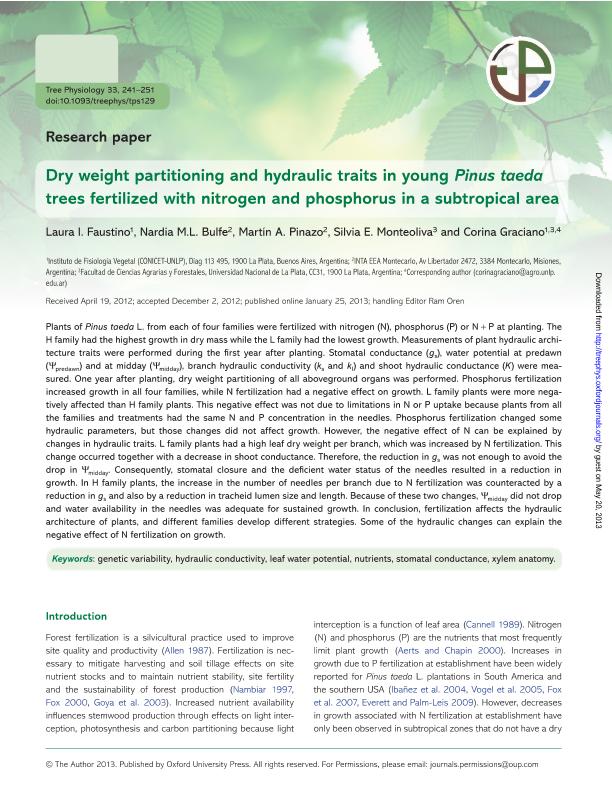Artículo
Dry weight partitioning and hydraulic traits in young Pinus taeda trees fertilized with nitrogen and phosphorus in a subtropical area
Faustino, Laura Inés ; Bulfe, Nardia M. L.; Pinazo, Martín Alcides; Monteoliva, Silvia Estela
; Bulfe, Nardia M. L.; Pinazo, Martín Alcides; Monteoliva, Silvia Estela ; Graciano, Corina
; Graciano, Corina
 ; Bulfe, Nardia M. L.; Pinazo, Martín Alcides; Monteoliva, Silvia Estela
; Bulfe, Nardia M. L.; Pinazo, Martín Alcides; Monteoliva, Silvia Estela ; Graciano, Corina
; Graciano, Corina
Fecha de publicación:
02/2013
Editorial:
Oxford University Press
Revista:
Tree Physiology
ISSN:
0829-318X
Idioma:
Inglés
Tipo de recurso:
Artículo publicado
Clasificación temática:
Resumen
Plants of Pinus taeda L. from each of four families were fertilized with nitrogen (N), phosphorus (P) or N + P at planting. The H family had the highest growth in dry mass while the L family had the lowest growth. Measurements of plant hydraulic architecture traits were performed during the first year after planting. Stomatal conductance (gs), water potential at predawn (Ψpredawn) and at midday (Ψmidday), branch hydraulic conductivity (ks and kl) and shoot hydraulic conductance (K) were measured. One year after planting, dry weight partitioning of all aboveground organs was performed. Phosphorus fertilization increased growth in all four families, while N fertilization had a negative effect on growth. L family plants were more negatively affected than H family plants. This negative effect was not due to limitations in N or P uptake because plants from all the families and treatments had the same N and P concentration in the needles. Phosphorus fertilization changed some hydraulic parameters, but those changes did not affect growth. However, the negative effect of N can be explained by changes in hydraulic traits. L family plants had a high leaf dry weight per branch, which was increased by N fertilization. This change occurred together with a decrease in shoot conductance. Therefore, the reduction in gs was not enough to avoid the drop in Ψmidday. Consequently, stomatal closure and the deficient water status of the needles resulted in a reduction in growth. In H family plants, the increase in the number of needles per branch due to N fertilization was counteracted by a reduction in gs and also by a reduction in tracheid lumen size and length. Because of these two changes, Ψmidday did not drop and water availability in the needles was adequate for sustained growth. In conclusion, fertilization affects the hydraulic architecture of plants, and different families develop different strategies. Some of the hydraulic changes can explain the negative effect of N fertilization on growth.
Archivos asociados
Licencia
Identificadores
Colecciones
Articulos(CCT - LA PLATA)
Articulos de CTRO.CIENTIFICO TECNOL.CONICET - LA PLATA
Articulos de CTRO.CIENTIFICO TECNOL.CONICET - LA PLATA
Articulos(INFIVE)
Articulos de INST.DE FISIOLOGIA VEGETAL
Articulos de INST.DE FISIOLOGIA VEGETAL
Articulos(SEDE CENTRAL)
Articulos de SEDE CENTRAL
Articulos de SEDE CENTRAL
Citación
Faustino, Laura Inés; Bulfe, Nardia M. L.; Pinazo, Martín Alcides; Monteoliva, Silvia Estela; Graciano, Corina; Dry weight partitioning and hydraulic traits in young Pinus taeda trees fertilized with nitrogen and phosphorus in a subtropical area; Oxford University Press; Tree Physiology; 33; 3; 2-2013; 241-251
Compartir
Altmétricas



